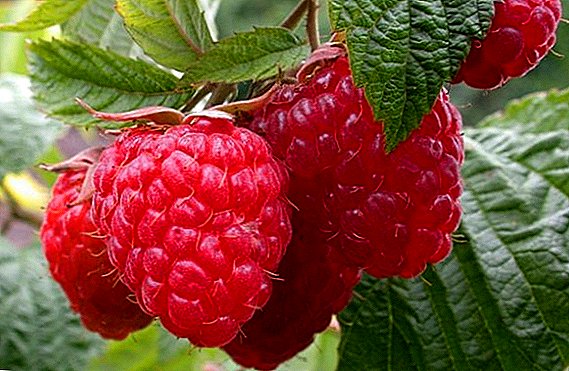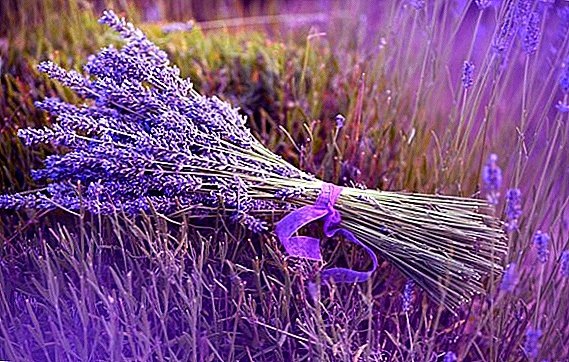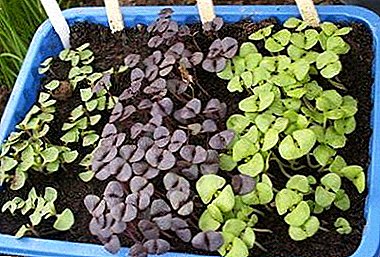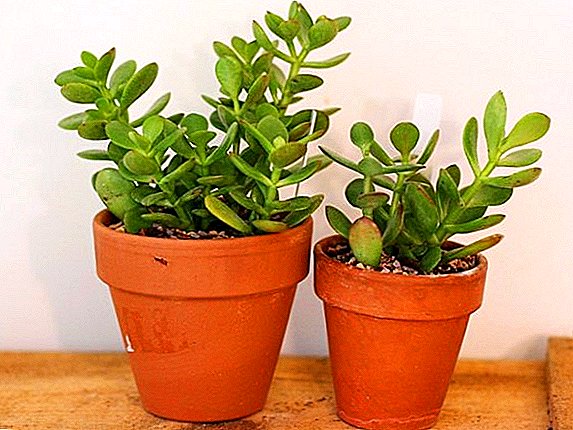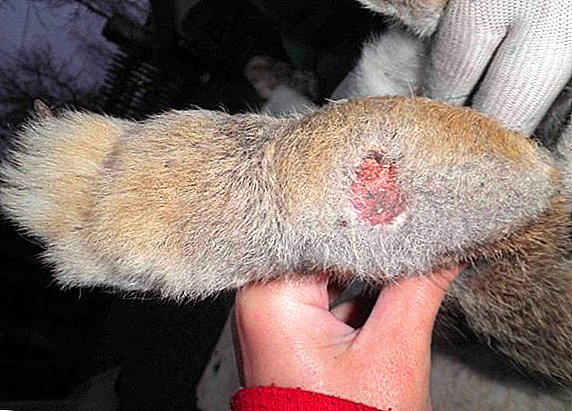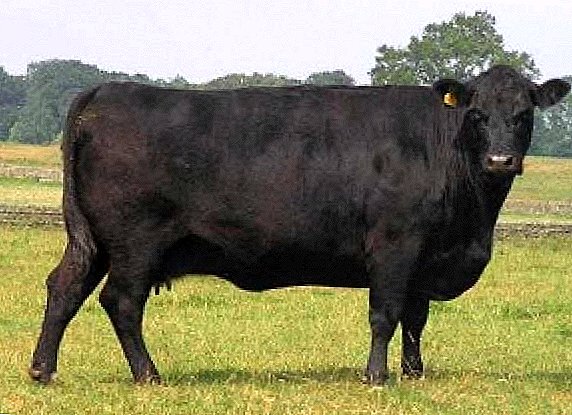 Ukrainians love garlic. They add it to many dishes, preparations for the winter, eat a bit of sugar with borscht. It is also used for the prevention and treatment of colds and viral diseases. Therefore, it grows in almost every household plot.
Ukrainians love garlic. They add it to many dishes, preparations for the winter, eat a bit of sugar with borscht. It is also used for the prevention and treatment of colds and viral diseases. Therefore, it grows in almost every household plot.
Consider useful tips on how to plant winter garlic.
Benefits of Autumn Planting
Garlic, planted in the fall, has several advantages over its spring "fellow". They are:
- consumption time: winter garlic is eaten in summer, while spring varieties sit in the ground;
- planting time: there is enough time in the fall to prepare the planting material and beds, you will not have to do this spring, when there is a lot of work on the plot without it;
- winter varieties are rarely affected by diseases and pests;
- with proper planting winter garlic are not afraid of cold;
- there is no need for watering, as winter snows and spring rains moisturize the earth sufficiently;
- the yield of winter garlic is higher than summer, and the cloves are larger;
- beds do not need frequent weeding, since young garlic appears before weeds and can drown them.
It is interesting to read about the properties and preparation of garlic: the benefits and harms of garlic, garlic arrows, dried and roasted garlic; recipes for the preservation of garlic and garlic arrows; storage of garlic.
The best varieties of winter garlic
Garlic varieties grown in Ukraine, a lot. But only some of them got into the State Register.
These include such winter varieties:
- "Sofievsky". Purple, arrowhead, sharp. In a bulb 5-6 big cloves. The vegetation period is 105-110 days. Stored well.
- "Prometheus". Gunman. White onion with 5-6 teeth. Vegetation period - 103 days. Storage capacity is medium.
- "Kharkov Purple". Gunman, very sharp. In the head 4-6 teeth. Vegetation period - 110-115 days. Average loginess. Good frost resistance (up to -25 ° C). High yield (14-16 t / ha). The bulbs have a high quality appearance.
- "Duchess". Early vegetation lasts 85-100 days (from the cloves) and 60-80 days (from the air bulbous). The bulb is white with purple stripes, consists of 5-6 large toothpicks. Very sharp.
- "Merefyansky white". Arrowed, medium-mature (105-110 days). The compact white head is 5-6 large teeth.
- "Spas". Gunman. Husk color is gray-purple with glitter. Universal application, sharp. Long stored: in good conditions can lie until early April. Resistant to nematode and fusarium. Can adapt to new conditions. High-yielding.
- "Leader". Unmanaged. Mid-hot. Bulb dirty white, weighing 30-35 g. Average resistance to nematode and fusarium. With proper storage may lie until early March.
- "Victory". Arrow, with very high arrows (up to 2 m). The average mature (110-115 days). Purple onion (35-40 g) consists of 5-6 cloves. The taste is spicy.
- "Starobelsky local". Gunman. The average mature (105-110 days). In white heads 4-6 large teeth. The taste is spicy.
- "Ukrainian White Gulyaypolsky". The most popular of non-flickers. It is applied both as spring, and as winter. Mature mid (100-120 days). Bulb irregular shape, silver-white color, multi-tooth, weight 20-23 g. The taste is sharp. Stored until the next harvest.





Did you know? Garlic is mentioned in the first books of the Bible. This proves that a few thousand years ago it was already a popular spice..
When to plant garlic for the winter in Ukraine
To get a good harvest, garlic must be planted on time. Planting time should be calculated so that before the onset of frost the teeth are well rooted, but do not have time to germinate. Only with sufficiently developed roots the garlic will easily overwinter and will not freeze even at a temperature of -25 ° C. To do this, it must be planted 35-45 days before the onset of frosts.
Pay attention to the temperature of the soil: it should fall to + 10 ... + 12 ° С and no longer rise. Otherwise, the planted teeth will quickly germinate, but they will not survive the winter.
Given the above conditions and region, experts recommend the following winter planting time frame:
- end of September - for the northern regions of Ukraine;
- the first half of October - for the central and western regions;
- the second half of October - for the southern region and Transcarpathia.
 Some gardeners agree on planting vegetables and the lunar calendar. As is known, the Moon affects not only the ebb and flow, but also the processes of vegetation in plants. For planting garlic and root vegetables, the right time is descending phase of the moon. During this period, the rise of groundwater, which saturate the soil with nutrients. In 2018, favorable days for planting winter garlic: September 4, 5, 12-15; October 11-13; November 8, 11, 16.
Some gardeners agree on planting vegetables and the lunar calendar. As is known, the Moon affects not only the ebb and flow, but also the processes of vegetation in plants. For planting garlic and root vegetables, the right time is descending phase of the moon. During this period, the rise of groundwater, which saturate the soil with nutrients. In 2018, favorable days for planting winter garlic: September 4, 5, 12-15; October 11-13; November 8, 11, 16.
Did you know? The name of the American city of Chicago literally translates from Indian as "wild garlic".
Choosing a landing site
Garlic loves a lot of sun. Therefore, for him to choose an open, well-lit area. Cooked area should be flat, without grooves. Otherwise, they will collect rainwater, contributing to the development of rot and disease. If the garden has a slope, then garlic is best planted higher.
Garlic soil should not be sour. If the acidity is high, then you need to make lime. Under the garlic, sandy and loamy soils are suitable, best of all chernozem.
Learn more about the composition of different soil types and soil acidity: the importance of soil acidity for different crops, how to independently determine the acidity of the soil and deoxidize the soil on the site.
It is important to consider which cultures were predecessors in this area.
The best are cucumbers, zucchini, pumpkin, eggplant, beans, cabbage and cauliflower, radishes and grains. After them, the land is already fertilized with useful organic substances.  You can not plant garlic after crops that are late harvested (potatoes, onions and garlic itself). They leave behind the depleted soil, which will not have time to recover before planting. Garlic can only be re-grown in 4-5 years.
You can not plant garlic after crops that are late harvested (potatoes, onions and garlic itself). They leave behind the depleted soil, which will not have time to recover before planting. Garlic can only be re-grown in 4-5 years.
Site preparation
Preparing a place for garlic begins with harvesting the previous culture. This should be done no later than 30-40 days before sowing, so that the earth will have time to rest.
The next stage of preparation should be carried out two weeks before landing. The selected area must be dug to a depth of 20-30 cm, while removing the roots of weeds. After that, it is desirable to fertilize the land. To do this, use both organic and mineral fertilizers. On 1 square. m will take 5-10 kg of humus. It can be mixed with chalk (2 tbsp.), Ash (2 tbsp.), Superphosphate (1 tbsp. L.) And potassium sulphate (2 tbsp. L.). If you water the soil with a solution (10%) of copper sulfate, this will serve as a defense against disease.
Important! Before planting garlic can not be fertilized with fresh manure. It will cause disease and decay..
Selection and preparation of planting material
The quality of the seed depends on the quality of the entire crop. Therefore, you need to choose only healthy teeth: dense, without damage and dents. Protective scales should be smooth and snug. The onion bottom should also be without cracks. If at least one tooth has an unhealthy appearance, it is worth rejecting the entire onion, since the other teeth can also be infected. From healthy garlic need to select the largest and most beautiful specimens. Large bulbs are formed from large cloves.  Selected material for sowing should be disinfected. Disinfection options:
Selected material for sowing should be disinfected. Disinfection options:
- pink solution of potassium permanganate (0.05-0.1%): soak for a day;
- solution of copper sulfate (1 tbsp. per bucket of water): leave for 24 hours;
- alkaline solution (400 g of ash per 2 liters of water): boil for 30 minutes, cool and soak the teeth for 2 hours;
- two-minute soaking in saline solution (3 tablespoons per 5 liters of water), then minute disinfection in a solution of copper sulfate (1 tsp. per bucket of water).
Important! Do not rush to throw out small teeth. If they are planted in a shaded place, for example, under a tree, they will be a source of fragrant green all spring and summer..
Landing rules
When planting garlic, the following important points should be considered:
- the distance between the rows should be at least 20-25 cm. This will make it easy to loosen the ground and remove weeds;
- the distance between the teeth varies depending on their size. Small specimens are planted 7–10 cm apart, and 13-15 cm are left between the large ones. With this arrangement, there will be enough space for the growth of the bulbs;
- depth of landing is also important. It affects the size of the landing copies. The depth of the grooves made in advance amounts to double the height of the teeth. For example, if a tooth is 3 cm high, then the depth of the hole should be at least 6 cm. Therefore, the seed should be sorted by size;
- no less important is how the teeth are sown in the grooves. They should be placed vertically, tightly pressed to the soil, but not strongly pressed. They need to be pressed in order to keep them upright when they fall asleep. So the head will be formed correctly.
Tips on growing garlic: planting and care in the open field; why does garlic turn yellow (winter garlic in spring), harvesting winter garlic.
Video: planting garlic in the fall in Ukraine
Subsequent work
After landing beds need to "warm", so that because of the frost not to lose the crop.
- Immediately after sowing, the rows should preferably be mulled: with sawdust, peat, humus, needles or leaves of trees. A layer of such "insulation" may be 2-10 cm.
- In winter, it is advised to cover the garlic patch with a layer of snow. It will serve as an additional "blanket", as well as a source of moisture during spring warming.
- Some gardeners in advance lay beds with brushwood to keep snow on them in winter.
In the spring, too, there is no time to rest, as the garlic needs to be fed. Immediately after the end of winter, you need to "feed" him: for 1 square meter. m take 6 g of ammonium nitrate, 9-10 g of superphosphate and 5-6 g of potassium sulfate. After a month, you can repeat this procedure, if necessary.
Yellowed lower leaves of garlic tops suggest that the harvest is already ripe. Winter garlic is harvested a month earlier than spring.
Video: growing winter garlic in Ukraine
Growing garlic requires some effort. But if you do everything right and on time, then all the costs will be repaid with interest.


